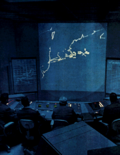Computer graphics
Computer graphics are pictures and films created using computers. Usually, the term refers to computer-generated image data created with the help of specialized graphical hardware and software. It is a vast and recently developed area of computer science. The phrase was coined in the 1960s and is also often abbreviated as CG, though sometimes referred to as CGI (Computer-generated imagery).
Overview[edit]
Computer graphics can be classified into distinct categories: raster graphics and vector graphics, with further 2D and 3D variants. Many powerful tools have been developed to visualize data in a computer-generated imagery format. Today, computer graphics are used in a wide variety of fields including but not limited to entertainment (video games, movies, television), science and medical research, engineering, and graphic design.
History[edit]
The history of computer graphics dates back to the 1950s and 1960s, where early experiments were conducted by pioneers like Ivan Sutherland, who created the Sketchpad in 1963, which was a revolutionary computer program that allowed users to draw directly on a display screen with a light pen. This period marked the beginning of CG as a field of study and set the foundation for the development of more sophisticated technologies.
Techniques[edit]
Computer graphics techniques are numerous and varied, including:
- 3D modeling - The process of developing a mathematical representation of any surface of an object in three dimensions via specialized software.
- Texturing - The process of applying a surface to a 3D model. This can include colors, patterns, and even bumps to simulate a real-world object more closely.
- Rendering - The process of generating an image from a model by means of computer programs. Rendering can be realistic or stylized, depending on the desired outcome.
- Animation - The process of creating motion and shape change illusion by means of the rapid display of a sequence of static images that minimally differ from each other.
Applications[edit]
The applications of computer graphics are broad and dynamic. Some of the primary applications include:
- Entertainment: Computer graphics are heavily used in making movies, video games, and virtual reality. CGI is used to create both realistic and fantastical elements within these mediums.
- Simulation and Training: Flight simulators, medical training, automotive design, and architectural visualization are areas where computer graphics play a crucial role in simulating real-world scenarios for training and design purposes.
- Scientific Visualization: In scientific research, computer graphics are used to visualize complex data sets and phenomena, making it easier to understand and interpret scientific results.
- Graphic Design: From logo creation to website design, computer graphics are essential in creating visual content for marketing, advertising, and communication.
Future Trends[edit]
The future of computer graphics is promising with the advent of technologies like augmented reality (AR), virtual reality (VR), and artificial intelligence (AI). These technologies are expected to drive further innovation in the field, creating more immersive and interactive experiences.
See Also[edit]
References[edit]
<references/>
Computer_graphics[edit]
-
Blender 2.45 screenshot
-
Geabios alps
-
SAGE control room
-
Spacewar! PDP-1
-
Pong
-
Helix, v.4, no.4, Aug. 15, 1968
-
Utah teapot
-
Donkey Kong arcade
-
Quarxs Affiche
-
Killing Floor Biohazard
-
Physically Based Rendering Sample
-
Blit dot
Ad. Transform your life with W8MD's Budget GLP-1 injections from $75


W8MD offers a medical weight loss program to lose weight in Philadelphia. Our physician-supervised medical weight loss provides:
- Weight loss injections in NYC (generic and brand names):
- Zepbound / Mounjaro, Wegovy / Ozempic, Saxenda
- Most insurances accepted or discounted self-pay rates. We will obtain insurance prior authorizations if needed.
- Generic GLP1 weight loss injections from $75 for the starting dose.
- Also offer prescription weight loss medications including Phentermine, Qsymia, Diethylpropion, Contrave etc.
NYC weight loss doctor appointmentsNYC weight loss doctor appointments
Start your NYC weight loss journey today at our NYC medical weight loss and Philadelphia medical weight loss clinics.
- Call 718-946-5500 to lose weight in NYC or for medical weight loss in Philadelphia 215-676-2334.
- Tags:NYC medical weight loss, Philadelphia lose weight Zepbound NYC, Budget GLP1 weight loss injections, Wegovy Philadelphia, Wegovy NYC, Philadelphia medical weight loss, Brookly weight loss and Wegovy NYC
|
WikiMD's Wellness Encyclopedia |
| Let Food Be Thy Medicine Medicine Thy Food - Hippocrates |
Medical Disclaimer: WikiMD is not a substitute for professional medical advice. The information on WikiMD is provided as an information resource only, may be incorrect, outdated or misleading, and is not to be used or relied on for any diagnostic or treatment purposes. Please consult your health care provider before making any healthcare decisions or for guidance about a specific medical condition. WikiMD expressly disclaims responsibility, and shall have no liability, for any damages, loss, injury, or liability whatsoever suffered as a result of your reliance on the information contained in this site. By visiting this site you agree to the foregoing terms and conditions, which may from time to time be changed or supplemented by WikiMD. If you do not agree to the foregoing terms and conditions, you should not enter or use this site. See full disclaimer.
Credits:Most images are courtesy of Wikimedia commons, and templates, categories Wikipedia, licensed under CC BY SA or similar.
Translate this page: - East Asian
中文,
日本,
한국어,
South Asian
हिन्दी,
தமிழ்,
తెలుగు,
Urdu,
ಕನ್ನಡ,
Southeast Asian
Indonesian,
Vietnamese,
Thai,
မြန်မာဘာသာ,
বাংলা
European
español,
Deutsch,
français,
Greek,
português do Brasil,
polski,
română,
русский,
Nederlands,
norsk,
svenska,
suomi,
Italian
Middle Eastern & African
عربى,
Turkish,
Persian,
Hebrew,
Afrikaans,
isiZulu,
Kiswahili,
Other
Bulgarian,
Hungarian,
Czech,
Swedish,
മലയാളം,
मराठी,
ਪੰਜਾਬੀ,
ગુજરાતી,
Portuguese,
Ukrainian












